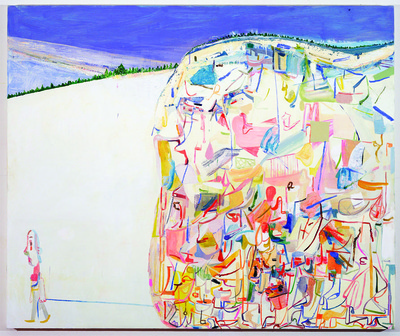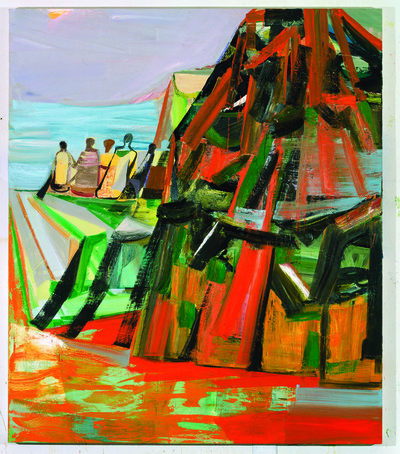Amy Sillman: one lump or two
As the title for a mid-career retrospective organized by the ICA, Boston, Amy Sillman: one lump or two, sounds cozy and whimsical, an art exhibition cast as a pleasant chat over tea. Then one recalls a similar question once was asked by Bugs Bunny before he delivered whacks to the head of the unsuspecting Pete Puma. Sillman’s own humor, delivered in a bemused, just-between-us tone, abounds in her art, particularly in the cartoons that punctuate the exhibition with running side-commentary.
Calling her goal “a rescue of gestural form from its bad ideology,” meaning the aesthetic and political boxes in which postwar American abstraction found itself, Sillman reinvigorates a beloved painterly mode by shrugging off its baggage. Her wit disarms expectations, allowing her to explore modernist form in a contemporary manner, invention flowing seemingly unfiltered from an endlessly turning mind and hand. “Painting is a physical thinking process to continue an interior dialogue,” Sillman writes, and the many joking asides in her drawings and paintings are only one level of conversation bubbling through her work.

Above: Amy Sillman, Me & Ugly Mountain, 2003, oil on canvas, 60 x 72″.
Collection of Jerome and Ellen Stern. Photo: John Berens.
Is Sillman the funniest contemporary artist going? She must make the short list, along with William Powhida and Britain’s Grayson Perry. Sillman dabbles in art world satire that reminds one of the former, yet her wit typically registers a different tone than Powhida’s obsessive mock-grandiosity, or Perry’s gently ironic social anthropology. Her various cartoon diagrams of dinner parties may describe a hell of pointed forks and sharp faces (“Bon vivant in a bow tie—really knows how to work the room”), but they do so from the knowing vantage point of an observer askew and decidedly apart. A crossed-out portrait from her early series Williamsburg has the words, “This painting is a total failure” written across its face, one of several comments about the work delivered by the artist to the viewer, to whom this flop is nonetheless displayed. This direct, self-deprecatory voice, part of yet outside the piece, appeals through its ambivalence and immediacy. Scrawled messages (“For crying out loud,” “Beats me,”) arranged like the beams of an unhappy sun, radiate in 1998’s Good Grief. In these and other works Sillman appears as the painter of the uncertain, the body-shamed, and all those who suffer from imposter syndrome.
All this might only amount to a darker, downtown gallery version of Roz Chast. Yet Sillman’s charmingly neurotic inner dialogue has spun itself into a robust body of painting over the past decade. In her words, Sillman’s works “are built for comfort, not for speed,” although a canvas like Big Girl, 2006, speaks as much about power as it does pleasure. A rising mass of thick, roughly horizontal black lines with black and green vertical supports builds to create an armature for juxtapositions of reds, grays, blues, and pinks. The result is not a grinning monster, like one of de Kooning’s Woman paintings, but a discovery. Surprising in its mass and color compared to her earlier work, one can almost feel the artist stretching out, discovering a capacity for expressive painting previously only suggested—a big girl ready to stake a claim to the realm of the big boys of postwar American painting.

Amy Sillman, Regarding Saturna, 2005, oil on canvas, 84 x 72″.
Collection of Gregory R. Miller and Michael Wiener, New York.
Photo: John Berens
The most impressive and affecting paintings in the exhibition occur when Sillman disciplines her exuberance. A group of abstract works, based in part upon drawings done of couples together, possesses a concentration and balance not always present in the stream of painterly consciousness that marks her other canvases. In C, the deliberate building of lines and shapes of color out of thick, steady paint application provide a rhythm that grows to feel inevitable and necessary. The points of intersection or contrasting trajectories of the geometries that create a sensitive interplay. They contrast with the roughness of her forms. There’s a hesitating delicacy built upon a structural solidity that reminds one of Richard Diebenkorn.

Amy Sillman, C, 2007, oil on canvas, 45 x 39″.
Collection of Gary and Deborah Lucidon.
Photo: John Berens.
The gallery label for Black Doorway, 2012, invokes original Museum of Modern Art director Alfred Barr rhapsodizing about black squares. I found myself wondering instead about a more recent moment in MoMA history: the display there in 2010 of Matisse’s Bathers by a River. Sillman’s painting, in its dominant colors of green, gray, and black, seems to recall that work without resembling it. It’s tempting to imagine the mature artist seeing a familiar work, normally hung in her hometown of Chicago and recently shown in New York, and accepting its challenge. Other recent paintings show Sillman opening her forms again, spinning out large, diagrammatic images in loosely scratched strokes against luridly colored backgrounds. Here one feels the central presence of one big idea in each canvas, twisting under examination, a hubbub of other murmured thoughts and doubts below. Experiments with animations assembled from drawings done on the iPad and iPhone provide a new medium for Sillman’s fluid, changing thoughts, giving her new ways to show their shifting shapes, each transforming and negating the last. Ambivalence holds many attractions: why have one mind when you can have two? Or as Bugs said to poor old Pete, drawing him in, “There’s nothing as sociable as a nice cup of tea.”
Joe Leduc is an occasional contributor to Art New England.
Amy Sillman: one lump or two
On view through January 5, 2014
The Institute of Contemporary Art/Boston
Boston, MA
icaboston.org
